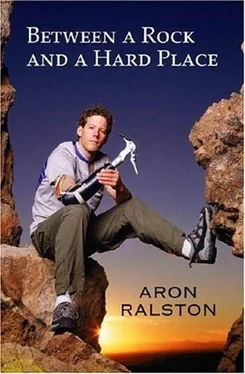The next summer, 1989, I went to an outdoor adventure camp that ranged across the state, including rock climbing near Estes Park, white-water rafting on the Colorado River out near Grand Junction, and horseback riding at a ranch near Gunnison. I wasn’t exactly turning into an expert, but something was growing in me, and four years later, when I headed off for college in Pittsburgh at Carnegie Mellon University, I felt like I’d established an identity in the West. I had become a Coloradoan at heart-a “transplanted native.” In Pennsylvania, when I felt homesick, it was for the spaces, sun, and peaks of my western home, and when people asked where I was from, I enjoyed seeing their eyes light up after I told them I was from Colorado. For two years, I was the only student at CMU from Colorado. Lacking fellow Coloradoans with whom I could share my longing for the Rocky Mountains, I pined disconsolately for snowy ski slopes.
I climbed my first fourteener, Longs Peak-one of the fifty-nine mountains in Colorado higher than the magic line of 14,000 feet-in July 1994, with my best friend, Jon Heinrich. Longs dominates the northern half of Colorado’s Front Range, northwest of Boulder. At 14,255 feet, the mountain is the sixteenth-highest peak in the state, and one of the most renowned. While its spectacular East Face, known as the Diamond, draws world-class technical climbers to its sheer granite lines, the relatively easy standard hike through the Keyhole allows thousands of scrambling hikers to make the summit each summer. Jon and I gathered advice from Dick Rigo, our friend Brandon’s dad, who had been a Boy Scout leader and who had himself climbed several dozen of the fourteeners. Mr. Rigo told us some basic tenets of hiking high peaks-start early, take water and food, rain gear, a map, and be off the summit by noon to avoid lightning from the almost daily afternoon thunderstorms-most of which we subsequently ignored.
Jon carried a gallon jug of water in his grip; our packs were stuffed with sandwiches, candy bars, and our ski jackets. By the time we reached treeline, the elevation above which trees no longer grow (about 11,000 feet on Longs Peak), we had stripped off our shirts and slathered sunscreen on our chests. We noted our progress compared to the photocopied trail map we’d picked up at the ranger station that morning, marking down the time we reached each landmark. We were going to be a long way behind the record ascent time, but we would easily get back before dark. A broad trail ascended to Granite Pass near 12,000 feet, and in a set of a half-dozen long switchbacks, the route turned back above itself several times to reach the Boulderfield, a half square mile of couch-sized boulders piled over one another. We ate a snack under the clear sky at the Keyhole, a steeply sided, jagged notch in the northern ridge of the mountain. Then I climbed up the rocks on the north side of the Keyhole and crawled out onto the overhanging pinnacle some thirty feet above Jon. With my legs dangling over the drop, he took my picture. I came down, Jon climbed up, and I returned the favor.
Even though we were well above 13,000 feet, the most difficult climbing of the day was still to come, with first a treacherous traverse across the granite slabs that slope down the west side of the north ridge, then a steep climb up the Trough Couloir, a five-hundred-foot-high rocky gully, where we encountered a dozen other hikers who were having increasing difficulty breathing under the exertion of scrambling up the couloir (the air near 14,000 feet is about half the density of air at sea level, so the available oxygen is significantly reduced). Jon suggested we race to the top of the couloir, one at a time, and see how many people we could pass. He went first and eventually passed everyone else in the couloir. While Jon was nearing the halfway point, I started up. Trying to pace myself to overtake a couple before the gully narrowed at a four-foot-high rock step, I felt my breathing escalate, but since I was unacclimated to the altitude, my chest could heave only so much until the fiery sensation in my lungs won and I had to pause at the rock step. Though I still passed all the other hikers, I was several minutes slower than Jon. It was significant to me that it could feel so good to make my body hurt by pushing so hard.
Approaching 14,000 feet under our own power for the first time, Jon and I felt giddy with the promise of making it to the top. But first we rounded an outside corner and were looking up at the Homestretch, a three-hundred-foot-high open dihedral formed at the crease where two sections of the summit walls create an inside corner, like an open book.
The last task before we would stand atop Longs Peak was to scramble up this smoothly polished slab using both hands on the rock. Below us, the rock walls fell away into a two-thousand-foot-deep chasm, from which an occasional wind gust burst, sharpening the psychological edge. Jon and I stopped to watch a summiteer descend the Homestretch above us in his blue jeans. He faced out from the mountain and alternated lowering his feet and scraping his underside down to meet his shoes. His tentative style in such a precarious place concerned us; we joked that if he slipped, he would knock us both off the Homestretch, like bowling for climbers. At a protected spot behind a large flake that had separated from the wall, we passed the man in the flat lee of the protrusion and continued. In another three minutes, we reached the open rocky plateau of Longs Peak and celebrated with an extended hug. Jon made a sign on the back of our map that read “I love you,” for his girlfriend, Nikki, and I took a photograph of him holding the paper in the breeze, beaming a hypoxic smile.
Despite our late start, we were off the summit and climbing down the Homestretch before two o’clock in the afternoon. A few clouds were gathering to the northwest, but we’d lucked out with the weather. Once we were down below the Keyhole again, we stopped for another snack and spied an open snow slope to our right, on the east side of the north ridge. I think the idea came to Jon and me at the same moment, because we looked at each other and said, “Let’s go slide on the snow!” I don’t think either of us knew what glissading was, but we clambered over to the top of the longest stretch of snow, some two hundred yards long, and donned our ski pants. It was a slope steep enough to avalanche, but with midsummer conditions, we were more concerned that we would slide all the way off the bottom edge and go hurtling into the Boulderfield. Jon went first on a thirty-second ride, spraying the softened snow in all directions with his boot heels, hooting with glee. I yelled for him to take a photo of me when I got close enough, and I plopped onto the snowfield and accelerated toward Jon at breakneck speed.
Using the snow groove Jon had created, and with my low-friction nylon ski pants, I quickly surpassed the speed where I could control my descent. Bouncing over buried obstacles, tearing down in a streak, I was going to end up staining some rocks with blood if I didn’t slow down. In fear, I thrust my hands down into the snow at my sides, dug in my heels, and was instantly rewarded with a faceful of heavy wet slush. As the slope angle diminished at the end of the snowfield, I raked my fingers more tenaciously and kicked with my boots until, half blind, I stopped right beside Jon, just a few feet before the rock field. We immediately broke into a bout of exuberant laughter and shouted at each other, “Let’s do it again!” Hiking up back to where we’d left our backpacks, I tried to revive my numbed hands, wiping off the ice crystals, and devised a scheme to hold small pointed rocks as brakes this time.
Once we were done terrifying ourselves, we hiked down to Granite Pass and traversed across Mount Lady Washington’s eastern flank. Clouds had started to move in by the time Jon and I reached treeline, and we shifted into a run to beat the coming rain. Pounding down the trail in our boots, we christened this first trail-running escapade Rapid Mountain Descent, or RMD for short. By the time we returned to the Land Cruiser, I had been thoroughly infected by the overall experience of climbing my first fourteener and knew that I would be up for more.
Читать дальше












